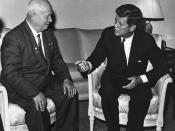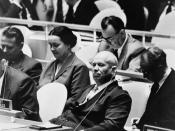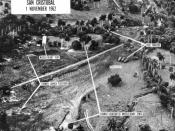Near World Destruction and Nuclear destruction, when those two devastating and frightening words are brought up one thought comes to mind, The Cuban Missile Crisis. This was the closest the world has ever come to being blown apart by the people living on it. In April 1962, Soviet Premier Nikita Khrushchev conceived the idea of placing intermediate-range ballistic missiles in Cuba. Placing IRBM in Cuba would double the Soviet strategic arsenal and provide a real deterrent to a potential U.S. attack against the Soviet Union or Cuba. In mid-July of 1962 the Soviet Union began its buildup of offensive weapons in Cuba. The fate of millions literally hinged upon the ability of two men, President John F. Kennedy and Premier Nikita Khrushchev. The near destruction of the world was brought upon by, The Cold War, faulty communications amongst Soviet and U.S. leaders, and personality conflicts amongst the two leaders. The crisis only lasted 14 days but it seemed like an eternity as the world watched at waited to see what would happen.
The Cold war, which began in 1945, was a period of Eastern-Western world competition, tension, and conflict short of full-scale war, characterized by mutual perceptions of hostile intention between military-political alliances or blocs. The end of World War II saw two great nations rise, the Soviet Union, and the United States. After the fall of Nazi Germany, both nations along with Britain and France competed for the grand prize of Central Europe: Berlin. This was only the beginning of uneasy tensions. The Soviet's hunger for nuclear knowledge coupled with their thirst for world domination; this did not mix well with the democratic society of the United States. When the Soviets detonated their first atomic bomb in 1949, tensions between the two countries began to reach a high point.


